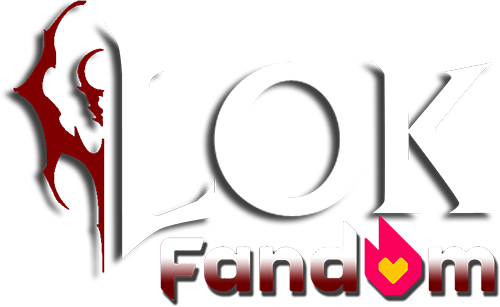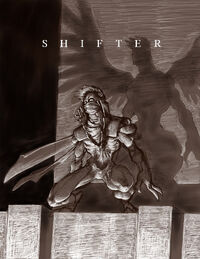
Shifter concept art by Arnold Ayala.
Shifter was a precursor project to Legacy of Kain: Soul Reaver: a video game proposal conceived circa 1997 by Amy Hennig, Seth Carus, and Arnold Ayala of Crystal Dynamics.
Though originally envisioned as a standalone concept, Shifter became associated with Legacy of Kain soon after Crystal Dynamics (later with Eidos Interactive) secured rights to continue the series. Before production on the game began, Hennig's management asked her team to adapt the proposal into a sequel to Blood Omen: Legacy of Kain. The existence of the Shifter project, and its relation to Soul Reaver, did not publicly come to light until 2002.
Shifter's post-apocalyptic story outline was loosely influenced by John Milton's Paradise Lost, and included prototypical versions of the characters of Raziel, Elder Kain, the Council, and the Elder God. Most of the proposal's core features carried over to Soul Reaver; the ideas of shifting between planes, gliding, and open world data streaming survived into the final product, relatively unchanged.
Profile[]
- "I don’t know how many people know this, but initially, it wasn’t actually a sequel to Blood Omen: Legacy of Kain at all – our original proposal was a concept for a new IP we named “Shifter,” loosely inspired by Paradise Lost. The protagonist was essentially a fallen angel of death, a reaper of souls hunted by his former brethren, and now driven to expose and destroy the false god they all served."
- ―Amy Hennig, PlayStation Blog, 2012[src]
Behind the scenes[]
Initial discovery[]
Soul Reaver credited Amy Hennig and Seth Carus for its "Original Game Concept," and Arnold Ayala for "Initial Concept Art."[Soul Reaver] Hennig mentioned in interviews that the game was first conceptualized around February 1997, and entered full production in October of that year. She stated that its total development cycle lasted about two and a half years.
The production of Soul Reaver had been overshadowed by an ongoing lawsuit between the developers of Blood Omen, Silicon Knights, and its publishers, Crystal Dynamics: a fight for ownership of the franchise.[1] Silicon Knights alleged that Crystal Dynamics had stolen their concept for "Kain II", and attempted to prevent the new game from being marketed. The dispute was privately resolved, and Crystal Dynamics ultimately retained permission to use the Blood Omen intellectual property.[1]
Later, in 2002, Silicon Knights president Denis Dyack posted a public comment at IGN concerning these events, which divulged new specifics about the origins of Soul Reaver:
"In fact, Razeal was never meant to be in the Kain series at all. Originally he was in a game originally titled Shifter – a game with an angelic theme where you shifted between 2 planes to complete the game. Crystal Dynamics did not have confidence that this game would do well as an original title so midway through the development cycle they slapped Legacy of Kain title on it, gave Razeal the Soul Reaver and went on to call it Soul Reaver. Many people ask us if we like the direction they have gone in but it is so alien to what we created it is pointless to answer now.
"We understand that some people love the Soul Reaver series and we think that is great. However, it is not what we would ever have done."Crystal Dynamics did not directly acknowledge Dyack's synopsis, but, in 2004, Ben Lincoln, of The Lost Worlds fansite, made a post challenging some of his contentions. Lincoln said:
"Soul Reaver was Amy Hennig's idea from the beginning. I don't know the details of how it got transformed from Shifter into a Legacy of Kain game, but it was not through SK in any way.
"It is also important to realize that Shifter was just a concept. It's not like there's a playable version of it to get your hands on. The details of the document describing it will probably be secret for the forseeable future too - it's an internal thing, not one for public release. The only reason Denis knows about it is because it was discussed during the legal issue his company and Crystal Dynamics had."I also very much doubt that SK had any plans for a sequel to Blood Omen. They were working on Too Human during BO's production, and spent years on it afterwards too.
"They might have had some vague ideas about a sequel, but given that in the eight years since BO they've only put out one game (Eternal Darkness), I doubt it would have ever materialized."The only connection SK has to the rest of the series is what they introduced in Blood Omen. Everything else is Crystal Dynamics in general, and Amy Hennig and her team in particular."
Legacy of Kain: Defiance environment artist Desdemon endorsed this account, replying, "Ben summed it up pretty well. Anything more I could add is confidential."
In 2007, Lincoln reiterated his description of Shifter in an article on his website. He said, "no actual production work was ever done on Shifter as a standalone title - it was strictly a paper design document. Although its influence on the final game is obvious, Soul Reaver was firmly set in the same world as Blood Omen before any other work began on it." Lincoln also noted that "some fans further believed that because the concept was revealed by Dyack, Shifter had been a Silicon Knights project which was "stolen" in some way by Crystal Dynamics. This is also incorrect."[1]
However, in a 2008 interview with 1UP.com, Dyack reasserted his views. He mentioned that "when we were doing Legacy of Kain, we had a lot of research into vampire mythology and a lot of ideas on where we were going. Crystal Dynamics merged in this entirely different game that had nothing to do with the series and then slapped the IP on it, and that's where Soul Reaver came from." Definitive comment on the Shifter project from its original creators remained elusive.
Acknowledgement[]
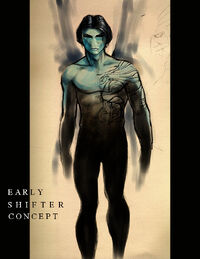
A piece by Ayala, labeled "Early Shifter Concept."
In 2010, Legacy of Kain fan Divine Shadow highlighted a blog portfolio created in 2009 by Arnold Ayala. It showcased Ayala's artwork for Soul Reaver, and some pieces were labeled "Shifter" or "Early Shifter Concept".[2]
While several of Ayala's designs had previously been released to promote Soul Reaver, Soul Reaver 2, and Defiance, none had been explicitly identified as media originally created for the "Shifter" proposal prior to this.[Soul Reaver][Soul Reaver 2][Defiance]
Divine Shadow attempted to interview Legacy of Kain series art director, Daniel Cabuco, on the subject of Shifter at Cabuco's website, DCabDesign, in 2012. However, Cabuco declined to discuss the project, citing legal constraints: "sorry, due to a legal settlement, I'm not at liberty to comment on this forum about details on Shifter or LOK. I wouldn't look too deep into Shifter, there really isn't as much there as you think. Meet me at a bar sometime and I may tell you more someday."
Later that year, though, Amy Hennig officially volunteered information on Shifter for the first time, in an interview with the PlayStation Blog:
"The Shifter concept was the genesis of the game that would become Soul Reaver; the core ideas were all there. The hero was an undead creature, able to shift between the spectral and material realms, and glide on the tattered remains of his wing-like coattails. We conceived the spirit realm as a twisted, expressionistic version of the physical world. The hero was bent on revenge after being betrayed and cast down by his creator – like Raziel, he was a dark savior figure, chosen to restore balance to a blighted, dystopian world.
"When we were asked to adapt this concept into a sequel to Blood Omen, our challenge was to take all these ideas and merge them creatively into the Legacy of Kain mythos."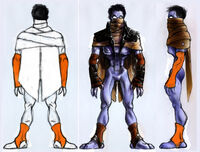
Orthography of the Shifter main character, by Ayala – with coattails in place of Raziel's wings.
The interview confirmed that Shifter was reconceptualized prior to entering production, and revealed that the team's plans had also included a number of secondary features that were pared back, including shape-shifting or morphing abilities. Even after"all the changes [they] went through over the course of development", Hennig described Soul Reaver as "pretty close" to the original proposal; she felt "the core concept of the game remained unchanged."
Hennig explained that Shifter's transformation into a Blood Omen sequel came about at the request of management in Crystal Dynamics. She and her team expressed discontent at this notion, but eventually agreed to rework their vision: "we were very invested in our original Shifter idea, so it naturally caused a bit of consternation when we were first asked to adapt the concept to be a Blood Omen sequel. But creative constraints can be inspiring and invigorating, and once we dug into the challenge, the concept evolved in all kinds of exciting ways."
Subsequent comments[]
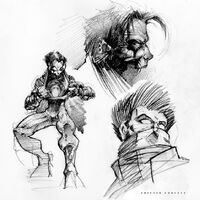
"Shifter Concept" drawings by Ayala.
Daniel Cabuco reacted to the interview by saying "it was nice that [Amy Hennig] could talk about the whole way SR came about from Shifter, too. I still steer clear of that whole thing due to the legal shenanigans." Nevertheless, he addressed a query about the cancelled shape-shifting feature: "the shape shifting in shifter was originally part of a body possession mechanic, whereas Raziel could only interact with the physical realm by possessing the bodies of other humans. We sort of did that with Defiance, but it wasn't like there was a beast form or wolf form for Raziel."
Hennig continued to relay anecdotes about the Shifter proposal in subsequent exchanges. In a 2012 interview with Electronic Gaming Monthly, she confirmed that the Shifter team consisted of only a couple of other people, and spoke again of their reluctance to merge their idea with the Legacy of Kain property:
"I'd said when I started at Crystal that I didn't necessarily want a management role, so I said, "I'll do it for like a year, but then I'd really like the chance to work on a project." After we finished Blood Omen, I started working with a very small team, just a couple other people, and the concept for something we were calling Shifter at the time, which became Soul Reaver.
"It wasn't originally intended to be a sequel to Blood Omen; it was a standalone idea but then, pretty shortly, management came to us and said, "We really love your idea, but we really want it to be a sequel to Blood Omen. Can you solve that problem?" After sort of wailing and gnashing our teeth, we just settled in and figured it out. That's what we do in this business: creativity within constraints."She offered more information on the project's story outline and key features in a 2013 interview with Game Informer's Matt Helgeson:
Despite the changes made to the mythology and title of Shifter in its transition to Soul Reaver, most of the team's goals, ideas, and sources of inspiration are distinguishable in the finished product. Soul Reaver includes angelic imagery and allusions to Paradise Lost, fully realized shifting between the Material and Spectral Realms, a freely explorable, expressionistic world with no loading times, and a post-apocalyptic, dystopian setting driven by motifs of Betrayal and redemption. Shifter's fallen hero, his treacherous creator, his brethren, and the dominant false god also persist into the Legacy of Kain universe – their essence present, albeit in a different context.[Soul Reaver][1][3]
Notes[]

Artwork of Shifter's protagonist by Ayala, officially categorized as concept artwork for Raziel.
- Crystal Dynamics exerted noticeable efforts to avoid disclosing the existence of the Shifter proposal, and their early disagreement concerning its integration into Legacy of Kain, during the production of the Soul Reaver trilogy. Amy Hennig mentioned that "it was the company that proposed the idea of a Blood Omen sequel to the team," but did not indicate that a standalone project had been altered to facilitate this. Richard Lemarchand's Defiance designer diaries referenced Paradise Lost and German Expressionism as early inspirations behind Soul Reaver and Raziel, but sidestepped the opportunity to mention Shifter itself. Sketches of the hero of Shifter were grouped under Raziel's concept artwork in bonus materials for Soul Reaver 2 and Defiance.[Soul Reaver 2][Defiance]
- Denis Dyack's 2002 revelations on the genesis of Soul Reaver – its beginnings as Crystal Dynamics' internally developed Shifter project – seemed to contradict Silicon Knights' prior allegations that the concept of Kain II had been taken from them by their former partners. Fans supposed that Shifter itself may have been this Silicon Knights concept, plagiarized by Crystal Dynamics.[1] In 2012, Divine Shadow publicized legal documents which clarified the matter: Kain II and Soul Reaver had been incorrectly conflated. The Kain II referred to by Silicon Knights was a separate project: after Blood Omen's release, Activision approached Crystal Dynamics and Silicon Knights to create competing proposals for a sequel, which incited the acrimony and litigation between both parties. Crystal Dynamics attained the rights to the series, Kain II was apparently cancelled, and Shifter – a distinct Crystal Dynamics creation – went unimpeded by Silicon Knights prior to assuming the place of Kain II as a sequel to Blood Omen.[4][5]
See also[]
 Shifter at The Lost Worlds (by Ben Lincoln).
Shifter at The Lost Worlds (by Ben Lincoln).
References[]
- ↑ 1.0 1.1 1.2 1.3 1.4
 Shifter at The Lost Worlds (by Ben Lincoln)
Shifter at The Lost Worlds (by Ben Lincoln)
- ↑
 Shifter - Initial project concept art, very early protagonist and antagonist designs. at Nosgothic Realm (by Divine Shadow)
Shifter - Initial project concept art, very early protagonist and antagonist designs. at Nosgothic Realm (by Divine Shadow)
- ↑
 Character Names at The Lost Worlds (by Ben Lincoln)
Character Names at The Lost Worlds (by Ben Lincoln)
- ↑ A post-mortem of Silicon Knights (Mama Robotnik research thread) at NeoGAF (by Mama Robotnik)
- ↑ The 10 Cancelled Legacy of Kains (Mama Robotnik Research Thread) at NeoGAF (by Mama Robotnik)
Browse[]
| |||||||||||||||||||||||||||
| |||||||||||||||||||||||||||
| |||||||||||||||||||||||||||
| |||||||||||||||||||||||||||
| |||||||||||||||||||||||||||
| |||||||||||||||||||||||||||
| |||||||||||||||||||||||||||
| |||||||||||||||||||||||||||
| |||||||||||||||||||||||||||
| |||||||||||||||||||||||||||
| |||||||||||||||||||||||||||
